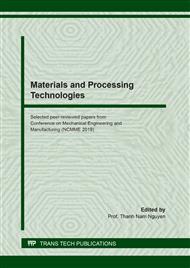p.33
p.51
p.59
p.67
p.73
p.79
p.85
p.97
p.103
Effect of 3D Printing Parameters on the Tensile Strength of Products
Abstract:
3D printing is a promising digital manufacturing technique that manufactures product parts in a layer fashion. Fused deposition modeling (FDM) is a widely used 3D printing technique that produces components by heating, extruding, and depositing the filaments of thermoplastic polymers. Meanwhile, the properties of FDM-produced parts are significantly influenced by process parameters. These process parameters have different advantages that need to be investigated. This paper examines the effect of some process parameters on the tensile properties of some components produced using FDM technique. The study is performed on polylactic acid (PLA) material, using full factorial experimental design. Furthermore, three process parameter—material, infill density, and infill pattern—are considered. The results indicate that only the infill pattern significantly influences the tensile properties of the model.
Info:
Periodical:
Pages:
103-108
Citation:
Online since:
September 2020
Authors:
Price:
Сopyright:
© 2020 Trans Tech Publications Ltd. All Rights Reserved
Share:
Citation:


